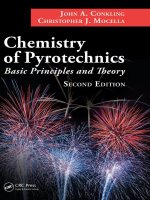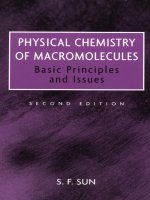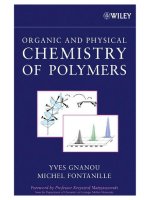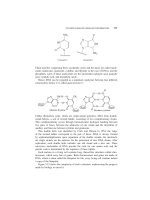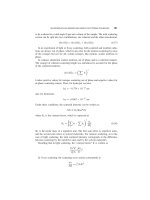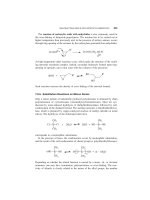Physical chemistry of metallurgical processes m shamsuddin (wiley TMS, 2016)
Bạn đang xem bản rút gọn của tài liệu. Xem và tải ngay bản đầy đủ của tài liệu tại đây (9.75 MB, 617 trang )
PHYSICAL CHEMISTRY OF
METALLURGICAL PROCESSES
PHYSICAL CHEMISTRY
OF METALLURGICAL
PROCESSES
M. SHAMSUDDIN B.Sc. (Met. Engg.), M.Sc. (Met. Engg.), Ph.D. (Met. Engg.)
Ex Professor and Head, Department of Metallurgical Engineering,
Banaras Hindu University, Varanasi, India
Copyright © 2016 by The Minerals, Metals & Materials Society.
All rights reserved.
Published by John Wiley & Sons, Inc., Hoboken, New Jersey.
Published simultaneously in Canada.
No part of this publication may be reproduced, stored in a retrieval system, or transmitted in any form or by any
means, electronic, mechanical, photocopying, recording, scanning, or otherwise, except as permitted under Section 107 or
108 of the 1976 United States Copyright Act, without either the prior written permission of The Minerals, Metals, &
Materials Society, or authorization through payment of the appropriate per-copy fee to the Copyright Clearance
Center, Inc., 222 Rosewood Drive, Danvers, MA 01923, (978) 750-8400, fax (978) 750-4470, or on the web at
www.copyright.com. Requests to the Publisher for permission should be addressed to the Permissions Department,
John Wiley & Sons, Inc., 111 River Street, Hoboken, NJ 07030, (201) 748-6011, fax (201) 748-6008, or online at
/>Limit of Liability/Disclaimer of Warranty: While the publisher and author have used their best efforts in preparing
this book, they make no representations or warranties with respect to the accuracy or completeness of the contents of this
book and specifically disclaim any implied warranties of merchantability or fitness for a particular purpose. No warranty
may be created or extended by sales representatives or written sales materials. The advice and strategies contained
herein may not be suitable for your situation. You should consult with a professional where appropriate. Neither the
publisher nor author shall be liable for any loss of profit or any other commercial damages, including but not limited
to special, incidental, consequential, or other damages.
Wiley also publishes books in a variety of electronic formats. Some content that appears in print may not be available
in electronic formats. For more information about Wiley products, visit the web site at www.wiley.com. For general
information on other Wiley products and services or for technical support, please contact the Wiley Customer Care
Department within the United States at (800) 762-2974, outside the United States at (317) 572-3993 or fax (317) 572-4002.
Library of Congress Cataloging-in-Publication Data:
Shamsuddin, M. (Mohammad), 1945–
Physical chemistry of metallurgical processes / M. Shamsuddin.
pages cm
Includes bibliographical references and index.
ISBN 978-1-119-07833-3 (cloth) – ISBN 978-1-119-07832-6 (oBook) – ISBN 978-1-119-07831-9 (ePDF) –
ISBN 978-1-119-07827-2 (ePUB)
1. Metallurgy. 2. Chemistry, Physical and theoretical. I. Title.
TN665.S4825 2016
669 .9–dc23
2015024793
Cover image courtesy of M. Shamsuddin.
Set in 10/12pt Times by SPi Global, Pondicherry, India
Printed in the United States of America.
10 9 8 7 6 5 4 3 2 1
1 2016
CONTENTS
Preface
Foreword
List of Symbols
xi
xvii
xix
1 Introduction
1
1.1 Thermodynamic Quantities and their Interrelationships, 5
1.1.1 General Thermodynamics, 5
1.1.2 Solution Thermodynamics, 15
Further Reading, 37
2 Roasting of Sulfide Minerals
39
2.1
2.2
2.3
2.4
2.5
2.6
Methods of Roasting, 40
Objectives, 41
Chemistry of Roasting, 42
Thermodynamics of Roasting, 43
Kinetics of Roasting, 47
Predominance Area Diagrams as a Useful Guide in Feed
Preparation, 51
2.7 Problems, 53
References, 68
3 Sulfide Smelting
3.1 Matte Smelting of Chalcopyrite, 72
3.1.1 Flash Smelting, 74
3.1.2 Submerged Tuyere Smelting, 76
71
vi
CONTENTS
3.1.3
3.1.4
3.2 Matte
3.3 Matte
3.3.1
Matte Converting, 76
Ausmelt/Isasmelt: Top Submerged Lancing (TSL) Technology, 80
Smelting of Galena, 83
Smelting of Nickel Sulfide, 85
Theory of Direct Conversion of Molten Nickel Sulfide
into Nickel, 87
3.4 Continuous Converting, 89
3.4.1 Noranda Continuous Converting Process, 90
3.4.2 Outokumpu Flash Converting Process, 90
3.4.3 Mitsubishi Continuous Converting Process, 91
3.5 Direct Metal Extraction from Concentrates, 92
3.5.1 Outokumpu Flash Smelting Process, 93
3.5.2 Mitsubishi Process, 94
3.6 Problems, 96
References, 100
4 Metallurgical Slag
103
4.1 Structure of Oxides, 103
4.1.1 Role of Ion Dimension, 104
4.1.2 Metal–Oxygen Bonds, 106
4.2 Structure of Slag, 108
4.3 Properties of Slag, 110
4.3.1 Basicity of Slag, 110
4.3.2 Oxidizing Power of Slag, 112
4.3.3 Sulfide Capacity of Slag, 112
4.3.4 Electrical and Thermal Conductivity, 113
4.3.5 Viscosity, 113
4.3.6 Surface Tension, 117
4.3.7 Diffusivity, 117
4.4 Constitution of Metallurgical Slag, 118
4.4.1 State of Oxidation of Slag, 120
4.5 Slag Theories, 125
4.5.1 Ionic Theories, 126
4.5.2 Molecular Theory, 130
4.6 Problems, 131
References, 143
5 Reduction of Oxides and Reduction Smelting
5.1 Reduction Methods, 146
5.2 Thermodynamics of Reduction of Oxides, 147
5.2.1 Metallothermic Reduction, 148
5.2.2 Thermal Decomposition, 154
145
CONTENTS
vii
5.2.3 Reduction with Carbon Monoxide, 155
5.2.4 Reduction with Hydrogen, 159
5.3 Kinetics of Reduction of Oxides, 161
5.3.1 Chemical Reaction with Porous and Nonporous Product Film, 162
5.4 Commercial Processes, 170
5.4.1 Production of Iron, 170
5.4.2 Production of Zinc, 174
5.4.3 Production of Tungsten and Molybdenum, 177
5.5 Problems, 179
References, 196
6 Interfacial Phenomena
199
6.1 Precipitation, 201
6.2 Nucleation of Gas Bubbles in a Liquid Metal, 205
6.2.1 Role of Interfaces in Slag–Metal Reactions, 208
6.3 Emulsion and Foam, 209
6.4 Froth Flotation, 211
6.5 Other Applications, 213
6.6 Problems, 214
References, 230
7 Steelmaking
7.1 Steelmaking Processes, 234
7.1.1 Bessemer Process, 234
7.1.2 Open Hearth Process, 235
7.1.3 Electric Arc Furnace (EAF) Process, 236
7.1.4 Top-Blown Basic Oxygen Converter Process, 236
7.1.5 Rotating Oxygen-Blown Converter Process, 238
7.1.6 Bottom-Blown Oxygen Converter Process, 239
7.1.7 Hybrid/Bath Agitated/Combined-Blown Process, 240
7.2 Physicochemical Principles, 242
7.2.1 Sulfur Reactions, 242
7.2.2 Phosphorus Reactions, 246
7.2.3 Silicon Reactions, 250
7.2.4 Manganese Reactions, 251
7.2.5 Carbon Reactions, 253
7.2.6 Kinetics of Slag–Metal Reactions, 256
7.3 Pre-treatment of Hot Metal, 261
7.3.1 External Desiliconization, 262
7.3.2 External Desulfurization, 262
7.3.3 External Dephosphorization, 262
7.3.4 Simultaneous Removal of Sulfur and Phosphorus, 263
233
viii
CONTENTS
7.4 Chemistry of Refining, 264
7.4.1 Bessemer Process, 264
7.4.2 Open Hearth Process, 266
7.4.3 Electric Arc Furnace (EAF) Process, 266
7.4.4 Top-Blown Basic Oxygen Converter Process, 267
7.4.5 Rotating Oxygen-Blown Converter Process, 272
7.4.6 Bottom-Blown Oxygen Converter Process, 274
7.4.7 Hybrid/Bath Agitated/Combined-Blown Process, 276
7.5 Problems, 279
References, 286
8 Secondary Steelmaking
289
8.1 Inert Gas Purging (IGP), 290
8.2 Ladle Furnace (LF), 291
8.3 Deoxidation, 291
8.3.1 Choice of Deoxidizers, 293
8.3.2 Complex Deoxidizers, 294
8.3.3 Vacuum Deoxidation, 299
8.3.4 Deoxidation Practice, 299
8.3.5 Removal of Deoxidation Products, 300
8.4 Stainless Steelmaking, 301
8.4.1 Physicochemical Principles, 302
8.4.2 Stainless Steelmaking Processes, 305
8.5 Injection Metallurgy (IM), 307
8.6 Refining with Synthetic Slag, 309
8.7 Vacuum Degassing, 311
8.7.1 Nitrogen in Iron and Steel, 312
8.7.2 Hydrogen in Iron and Steel, 315
8.7.3 Vacuum Treatment of Steel, 319
8.8 Problems, 325
References, 348
9 Role of Halides in Extraction of Metals
9.1 Preparation of Halides, 354
9.1.1 Complex Fluoride Processes, 354
9.1.2 Halogenation of Oxides, 355
9.1.3 Halogenation of Ferro-Alloys, 359
9.1.4 Crystallization from Aqueous Solution, 360
9.2 Purification of Chlorides, 362
9.2.1 Purification of Titanium Tetrachloride, 363
9.2.2 Purification of Columbium Pentachloride, 363
9.2.3 Purification of Vanadium Tetrachloride, 363
351
CONTENTS
ix
9.3 Metal Production, 364
9.3.1 Metallothermic Reduction, 365
9.3.2 Fused Salt Electrolytic Process, 369
9.4 Purification, 369
9.4.1 Disproportionate Process, 369
9.4.2 Iodide Process, 370
9.5 Problems, 370
References, 380
10
Refining
383
10.1 Principle, 384
10.2 Methods of Refining, 384
10.2.1 Fire Refining, 385
10.2.2 Metal–Metal Refining, 391
10.2.3 Metal–Gas Refining, 394
10.2.4 Miscellaneous Group, 400
10.3 Ultra-purification, 400
10.3.1 Zone Refining, 400
10.3.2 Electro-transport, 403
10.3.3 Iodide Decomposition, 404
10.4 Refining along with Melting and Consolidation, 409
10.5 Problems, 410
References, 420
11
Hydrometallurgy
11.1 Leaching, 425
11.1.1 Leaching Methods, 427
11.2 Breakdown of Refractory Minerals, 431
11.2.1 Concentrated Sulfuric Acid Breakdown, 432
11.2.2 Concentrated Alkali Breakdown, 432
11.3 Physicochemical Aspects of Leaching, 433
11.3.1 Thermodynamics of Aqueous Solutions, 433
11.3.2 Stability Limit of Water, 435
11.3.3 Potential-pH Diagrams, 437
11.3.4 Electrochemical Phenomenon in Leaching, 444
11.3.5 Kinetics of Leaching, 448
11.4 Treatment of Leach Liquor, 465
11.4.1 Chemical Precipitation, 466
11.4.2 Fractional Crystallization, 467
11.4.3 Ion Exchange, 468
11.4.4 Solvent Extraction, 476
11.5 Recovery of Metals from Leach Liquor, 492
11.5.1 Precipitation of Metal Sulfides, 492
11.5.2 Cementation, 495
423
x
CONTENTS
11.5.3 Gaseous Reduction, 502
11.6 Problems, 507
References, 519
12
Electrometallurgy
523
12.1 Principle, 525
12.1.1 Cell Potential, 527
12.1.2 Discharge Potential, 530
12.1.3 Current and Energy Efficiency, 532
12.2 Applications, 534
12.2.1 Electrowinning, 534
12.2.2 Electrorefining, 545
12.3 Problems, 549
References, 556
Appendixes
Index
559
585
PREFACE
I had been planning to write a book on Physical Chemistry of Metallurgical Processes
based on my experiences of teaching a graduate course with the same title at the
Department of Materials Science and Engineering, Massachusetts Institute of Technology and association/interaction with the faculty members of the Department of
Metallurgy and Metallurgical Engineering, University of Utah, Salt Lake City, during
my 3 years (1978–1981) of visit to the United States. But while taking account of rapid
development of the theoretical knowledge in recent years in gas–solid (roasting and
reduction) and liquid–solid (leaching and precipitation) reactions, I was in a dilemma
regarding the extent to which mathematical expressions should be incorporated in the
book. After spending a lot of time on the mathematical contents while teaching the
same course at the Department of Metallurgical Engineering, Banaras Hindu University, I concluded that it should be possible to discuss the new developments in a satisfactory manner without going into the use of advanced mathematics by giving more
emphasis on thermodynamics that brings out more convincing evidence as compared
to kinetics involving complex expressions. This decision has helped me in the preparation of a book of reasonable size covering various process steps in production of
different types of metals, namely common, reactive, rare, and refractory.
In the past, during 1950–1970, most textbooks on extractive metallurgy described
processes for production of different metals emphasizing the technology rather than the
basic principles involved. The physical chemistry of the processes has been restricted
to mere listing of chemical reactions expected to be taking place. However, the book
entitled Physical Chemistry of Iron and Steel Making by Professor R. G. Ward published in 1962 has been an exception. With rapid increase in the number of extraction
processes on the industrial scale, it became difficult to bring out the comprehensive
idea of all metallurgical fundamentals for the development of future technology.
xii
PREFACE
During 1970–1995, Professors C. Bodsworth, W. G. Davenport, J. F. Elliott, F. Habashi,
E. Jackson, J. J. Moore, R. H. Parker, R. D. Pehlke, T. Rosenqvist, H. Y. Sohn, M. E.
Wadsworth and Dr. E. T. Turkdogan paid due attention to the physicochemical aspects
of metallurgical fundamentals in their books. I have benefited from their texts while
preparing this manuscript and owe them most sincerely. In addition, I have tried to collect
information on this subject from different journals and proceeding volumes. For the
benefit of readers, important references have been listed in each chapter. This may also
be considered as a tribute to various academicians, researchers, and investigators associated with the publication of various books and research articles in different journals.
By giving more emphasis on the physical chemistry of different metallurgical processes, I aim to solve some of the problems. Attention has not been paid to how different processes are carried out; instead, the emphasis has been on why the step has
been adapted in a particular manner. These queries, with a clear understanding of the
physical chemistry, may open ways and means for future developments. Lecturing on
physical chemistry of metallurgical processes is associated with a number of challenging exercises and difficulties. It requires not only a thorough understanding of chemical reactions taking place in a process, but also a sound knowledge of chemical
thermodynamics and reaction kinetics. In addition, technical principles of heat
and mass transfer are also needed in designing a metallurgical reactor. Lastly, the
chemical-extractive metallurgist must know about the existing processes and should
be capable of employing his imagination in encouraging students/investigators in
improving the existing techniques.
Currently, university courses provide inadequate background in chemical/metallurgical thermodynamics. At the majority of institutions, thermodynamics courses
are formal. Often teachers feel satisfied by solving a few problems by plugging data
in the thermodynamic expressions derived in the class. In this book, the thermodynamic interrelationships concerning the problems have been summarized in
Chapter 1, and for clarity the thermodynamics quantities have been defined together
with an explanation of their physical significance. It has been presumed that readers
are familiar with the undergraduate course in chemical/metallurgical thermodynamics. For details, readers are advised to consult the textbooks and necessary compilations listed in this book. Reaction kinetics of different processes has not been covered
in detail, and topics on heat and mass transfer have not been included with the primary
objective of publishing a book of reasonable volume. Depending upon the response
from readers, it may be taken up in the second volume or edition.
The book deals with various metallurgical topics, namely, roasting of sulfide
minerals, sulfide smelting, slag, reduction of oxides and reduction smelting, interfacial phenomena, steelmaking, secondary steelmaking, role of halides in extraction of
metals, refining, hydrometallurgy, and electrometallurgy in different chapters. Each
chapter is illustrated with appropriate examples of application of the technique
in extraction of some common, reactive, rare, or refractory metal together with
worked-out problems explaining the principle of the operation. The problems require
imagination and critical analysis. At the same time, they also encourage readers for
creative application of thermodynamic data. Exercises have not been given because
I am confident that the worked-out examples provide ample platform for the
PREFACE
xiii
framework of additional problems. In selecting these problems, I am grateful to the
late Professor John F. Elliott of MIT and late Dr. Megury Nagamori of the
Noranda Research Center, Canada. I am not consistent in using the SI unit
throughout the book. Based on my long teaching experience of about four
decades, I strongly feel that the use of different units will make students mature with
regard to the conversion from one unit to another. The principal objective of the book
is to enlighten graduate students of metallurgy and metallurgical engineering specializing in chemical-extractive metallurgy and chemical engineering with the basic
principles of various unit operations involved in the extraction of different types of
metals. It will also be useful to senior undergraduate students of metallurgy and
chemical technology.
However, the success of the process is dictated by economic evaluation. The use of
thermodynamic principles and reactor design becomes insignificant if the process is
uneconomical and/or the product has poor demand. This aspect has not been considered in this book. I advise the industrial metallurgists and researchers to be careful
about the economic consequences of their work.
I am grateful to a number of friends and colleagues for necessary help in the preparation of the manuscript. It is not possible to mention all, but I shall be failing in my
duty if I do not thank Professor H. Y. Sohn of the University of Utah, Salt Lake City,
USA, Professor Fathi Habashi of the Laval University, Canada, and Professor T. R.
Mankhand of the Banaras Hindu University for their advice and constructive criticism
and also Dr. C. K. Behera and Dr. S. Jha of the Banaras Hindu University for their
assistance in the preparation of diagrams and the manuscript. I am also thankful to
library staffs of the Department of Metallurgical Engineering for their active cooperation in locating the reference materials. Although due acknowledgments have been
given to authors at appropriate places in the texts for adapting their tables and figures
published in various books and journals, I take this opportunity to thank the publishers
(authors as well) listed below for giving permission to reproduce certain figures and
tables:
I. ASSOCIATION FOR IRON & STEEL TECHNOLOGY (AIST)
1. Pehlke, R. D., Porter, W. F., Urban, P. F. and Gaines, J. M. (Eds.) (1975)
BOF Steelmaking, Vol. 2, Theory, Iron & Steel Society, AIME, New York
for Table 6.2 and Figs. 4.12, 4.14, 7.7, 8.1, 8.3, and 8.4.
2. Taylor, C. R. (Ed.) (1985) Electric Furnace Steelmaking, Iron & Steel Society,
AIME, New York.
i. Elliott, J. F. (1985) Physical chemistry of liquid steel, In Electric Furnace
Steelmaking, Taylor, C. R. (Ed.), Iron & Steel Society, AIME, New York
(Chapter 21, pp 291–319) for Figs. 8.1, 8.2, 8.3, 8.4, 8.7, 8.8, 8.9, 8.10,
and 8.11.
ii. Hilty, D. C. and Kaveney, T. F. (1985) Stainless steel making, In Electric
Furnace Steelmaking, Taylor, C. R. (Ed.), Iron & Steel Society, AIME,
New York (Chapter 13, pp 143–160) for Figs. 8.5 and 8.6.
xiv
PREFACE
3. Chipman, J. (1964) Physical chemistry of liquid steel, In Basic Open Hearth
Steel Making, Derge, G. (Ed.), AIME, New York (Chapter 16, pp 640–724)
for Figs. 7.4 and 8.7.
II. ADDISON-WESLEY PUBLISHING COMPANY, INC.
Muan, A. and Osborn, E. F. (1965) Phase Equilibria among Oxides in Steelmaking,
Addison-Wesley Publishing Company, Inc., Reading, MA for Fig. 4.14.
III. AMERICAN CERAMIC SOCIETY
Osborn, E. F. and Muan, A. (1960) Phase Equilibrium Diagrams of Oxide Systems,
American Ceramic Society, Columbus for Figs. 4.10 and 4.11.
IV. ASM INTERNATIONAL
Marshall, S. and Chipman, J. (1942) The carbon-oxygen equilibrium in liquid iron,
Trans. Am. Soc. Met. 30, pp 695–741 for Fig. 7.6.
V. BUTTERWORTH–HEINEMANN
Moore, J. J. (1990) Chemical Metallurgy, 2nd Edition, Butterworth–Heinemann,
Oxford for Figs. 4.1, 4.3, 4.7, 4.8, 5.1, 5.2, and 9.1.
VI. CRC PRESS
Bodsworth, C. (1990) The Extraction and Refining of Metals, CRC Press, Tokyo
for Fig. 10.1.
VII. DISCUSSION FARADAY SOCIETY
Peretti, E. A. (1948) Analysis of the converting of copper matte, Discuss. Faraday
Soc. 4, pp 179–184 for Fig. 3.1(b).
VIII. EDWARD ARNOLD
Ward, R. G. (1962) An Introduction to Physical Chemistry of Iron and Steel
Making, Edward Arnold, London for Figs. 7.2, 7.3, and 7.5.
IX. ELLIS HARWOOD LIMITED
Jackson, E. (1986) Hydrometallurgical Extraction and Reclamation, Ellis
Harwood Ltd. (a division of John Wiley), New York for Figs. 11.3, 11.4, 11.5,
11.6, 11.7, 11.8, 11.10, and 11.13 and Resin structures and chemical equations
related to solvent extraction equilibria.
PREFACE
xv
X. ELSEVIER
Davenport, W. G., King, M., Schlesinger, M. and Biswas, A. K. (2002) Extractive
Metallurgy of Copper, 4th Edition, Elsevier Science Ltd., Oxford for Figs. 3.1(a),
3.1(b), and 11.12 and data concerning smelting, converting and leach liquors.
XI. GORDON & BREACH
1. Habashi, F. (1970) Principles of Extractive Metallurgy, Vol. 1 General Principles, Gordon & Breach Science Publishing Co., New York for Table 5.1.
2. Habashi, F. (1970) Principles of Extractive Metallurgy, Vol. 2 Hydrometallurgy, Gordon & Breach Science Publishing Co., New York for
Table 11.1 and Figs. 11.11 and 11.14.
XII. JOURNAL OF IRON & STEEL INSTITUTE
1. Turkdogan, E. T. and Pearson, J. (1953) Activity of constituents of iron
and steelmaking slags, Part I, iron oxide, J. Iron Steel Inst. 173,
pp 217–223 for Fig. 4.12.
2. Balagiva, K., Quarrel, A. G. and Vajragupta, P. (1946) A laboratory
investigation of the phosphorus reaction in the basic steelmaking process,
J. Iron Steel Inst. 153, pp 115–145 for Fig. 7.3.
XIII. McGRAW-HILL
Rosenqvist, T. (1974) Principles of Extractive Metallurgy, McGraw-Hill, New
York for Figs. 2.1, 2.2, 4.15, 5.3, 5.4, 5.5, 11.2, and 11.9.
XIV. MESHAP SCIENCE PUBLISHERS, MUMBAI, INDIA
Shamsuddin, M., Ngoc, N. V. and Prasad, P. M. (1990) Sulphation roasting of an
off-grade copper concentrate, Met. Mater. Process. 1(4), pp 275–292 for Table 2.1
and Figs. 2.3, 2.4, 2.5, and 2.6.
XV. PERGAMON
1. Parker, R. H. (1978) An Introduction to Chemical Metallurgy, 2nd Edition, Pergamon, Oxford, Figs. 7.8.
2. Coudurier, L., Hopkins, D. W. and Wilkomirski, I. (1978) Fundamentals
of Metallurgical Processes, Pergamon, Oxford for Tables 4.1, 4.2, 4.3 and
4.4 and Figs. 4.2, 4.4, 4.5, 4.6, 4.7, 4.8, 4.9, 4.10, and 4.11.
XVI. PRENTICE HALL INTERNATIONAL
Deo, B. and Boom, R. (1993) Fundamentals of Steelmaking Metallurgy, Prentice
Hall International, London for Figs. 7.11 and 7.12.
xvi
PREFACE
XVII. THE INSTITUTE OF MATERIALS, MINERALS & MINING,
LONDON
Turkdogan, E. T. (1974) Reflections on research in pyrometallurgy and metallurgical chemical engineering, Trans. Inst. Min. Metall., Sect. C, 83, pp 67–23 for
Figs. 7.9 and 7.10.
XVIII. THE MINERALS, METALS & MATERIALS SOCIETY (TMS)
1. Rocca, R. N., Grant, J. and Chipman, J. (1951) Distribution of sulfur
between liquid iron and slags of low iron concentrations, Trans. Am.
Inst. Min. Metall. Eng. 191, 319, for Fig. 7.1.
2. Elliott, J. F. (1955) Activities in the iron oxide-silica-lime system,
Trans. Am. Inst. Min. Metall. Eng. 203, 485, for Fig. 4.13.
3. Queneau, P. E., O’Neill, C. E., Illis, A. and Warner, J. S. (1969) Some
novel aspects of the pyrometallurgy and vapometallurgy of nickel, Part
I: Rotary top-blown converter, JOM 21(7), 35, for Table 3.1.
4. Pehlke, R. D. and Elliott, J. F. (1960) Solubility of nitrogen in liquid
iron alloys, I Thermodynamics, Trans. Met. Soc., AIME. 218, 1088,
for Figs. 8.8 and 8.9.
5. Weinstein, M. and Elliott, J. F. (1963) Solubility of hydrogen at one
atmosphere in binary iron alloys, Trans. Met. Soc., AIME. 227, 382,
for Figs. 8.10 and 8.11.
XIX. THE INDIAN INSTITUTE OF METALS
Sundaram, C. V., Garg, S. P. and Sehra, J. C. (1979) Refining of reactive metals, In
Proceedings of International Conference on Metal Sciences – Emerging Frontiers,
Varanasi, India, November, 23–26, 1977, Indian Institute of Metals, Calcutta,
pp 361, for Table 10.2.
Last but not the least, I am extremely grateful to Mrs. Abida Khatoon for taking
care of the family, and for offering moral support and patience for my long hours
spent working on the book.
M. SHAMSUDDIN
FOREWORD
The limited availability of textbooks in chemical and extractive metallurgy is evident
from their paucity in different library websites. Hence, there is a need to enrich the
extractive metallurgy library. In this field, hardly one or two books are published
within a span of 5–10 years. Considering the requirement and circumstances, this
book by Professor M. Shamsuddin, which discusses the physical chemistry of various
steps involved in the extraction of different types of metals, is an important contribution in the field of chemical metallurgy. It is well known that the exploitation of many
low-grade and complex ores/minerals has been possible in recent years by a thorough
understanding of slag–metal reactions with the aid of thermodynamics and reaction
kinetics. The fundamental principles of chemical metallurgy are based on physical
chemistry that includes thermodynamics and kinetics. In general, textbooks on physical chemistry deal mainly with contents that are appreciated by the students of chemistry but are of less interest to metallurgists and chemical engineers. In this book,
physical chemistry is presented for aspects concerning chemical metallurgy with
appropriate examples drawn, as much as possible, from extractive metallurgical
processes.
The physical chemistry principles that are key to extraction technologies play a
decisive role in the development and improvement of processing methods. As a consequence, metallurgists and chemical engineers often face the problem in selecting the
appropriate technique for treatment of the concentrate. In order to overcome such a
challenging task, a sound knowledge of physical chemistry of different extraction
methods is extremely useful. Since the chemistry of the extraction process varies
according to the nature of the metal, which may fall under the categories of common,
rare, reactive or refractory, a comprehensive and collective treatment in one book is
very much desired at the present time. Depending on the interest, one may further
xviii
FOREWORD
study the details in a book/monograph dealing with the particular metal. This is the
main objective of this book.
This is a very special book for three reasons: Firstly, it includes discussions on
physicochemical principles involved in different steps, namely, roasting of sulfide
minerals, matte smelting/converting, reduction smelting, iron- and steelmaking, deoxidation, refining, degassing, leaching, purification of leach liquor, precipitation,
cementation, etc., during extraction/production of not only common metals but also
rare, reactive, and refractive metals by pyro- and hydrometallurgical methods. Secondly, it provides a number of worked-out examples in each chapter, which make
understanding of the process easier. Thirdly, the author has systematically summarized and presented scattered information on physicochemical aspects of metal extraction from previously published books and journal articles.
The book will undoubtedly fulfil the need of students and teachers by providing
information on the principles and methods of extraction of different metals: common,
rare, reactive, and refractory in one place. I am confident that the book will be in
demand throughout the world by universities and institutes offering courses in Metallurgy, Chemical Engineering and Technology, and also by various metallurgical and
chemical research laboratories. It will be more useful to students of metallurgical engineering specializing in chemical/extractive metallurgy, but the basic principles of various unit operations involved in extraction will also be appreciated by chemical
engineering students.
In addition to his long tenure at Banaras Hindu University, Professor Shamsuddin
has had diversified interactions with faculty members of two premier institutions,
namely the Department of Metallurgical Engineering, University of Utah, Salt Lake
City, and the Department of Materials Science and Engineering, Massachusetts Institute of Technology, Cambridge, on various aspects of metal extraction, thermodynamics, and kinetics. I have no reservation in stating most strongly that this book
on Physical Chemistry of Metallurgical Processes will achieve a high standard in
the field of chemical/extractive metallurgy and be appreciated by metallurgists and
chemical engineers.
H. Y. SOHN
Fellow, The Minerals, Metals & Materials Society
Professor, Departments of Metallurgical Engineering and Chemical Engineering
135 S 1460 E Rm 412
University of Utah, Salt Lake City, UT 84112-0114, USA
Tel: (801) 581-5491; Fax: (801) 581-4937
/>
LIST OF SYMBOLS
A
a
atm
B, b
c
C
Cp
Cv
d
D
DP
DS
e
E
EA
Eη
f
F
f(θ)
(g)
g
G
G‡
h
H
Area of surface, pre-exponential factor, frequency factor
Raoultian activity
Atmosphere (pressure)
Basicity
Concentration, constant
Heat capacity, component, constant
Heat capacity at constant pressure
Heat capacity at constant volume
Diameter
Diffusion coefficient
Dephosphorization index
Desulfurization index
Electron charge, interaction coefficient
Energy, electrode potential, emf, electron field mobility
Activation energy
Activation energy for viscous flow
Henrian activity coefficient, fraction reacted
Degree of freedom, Faraday constant
Shape factor
Gaseous phase
Acceleration due to gravity
Free energy
Free energy of activation
Planck constant, height (metal head)
Enthalpy
xx
J
k
km
K
K
L
Le
Lf
(l)
ln
m
M
n
N
N
p
P
pi
p
q
Q
Q
r
R
(s)
S
t
T
Te
Tf
U
v
V
ω
x
z
LIST OF SYMBOLS
Flux, (mass transferred per unit area per unit time), Joule
Rate constant, partition/segregation/distribution coefficient, Sievert’s constant, Boltzmann constant, kilo
Mass transfer coefficient
Equilibrium constant, distribution coefficient
Equilibrium quotient of cations
Latent heat of transformation, liter
Latent heat of evaporation
Latent heat of fusion
Liquid state, liter
Napierian logarithm (loge)
Mass
Atomic/molecular weight
Number of moles/atoms
Avogadro’s number
Electrically equivalent ionic fraction
Partial pressure
Total pressure
Partial pressure of the component i
Partial pressure of the pure component
Quantity of heat
Total extensive thermodynamic quantity
Molar extensive thermodynamic quantity
Radius, rate of evaporation
Gas constant, rate of reaction
Solid phase
Entropy
Time
Absolute temperature (Kelvin), temperature ( C)
Temperature of evaporation
Temperature of fusion
Internal energy
Rate of rise of the deoxidation product, volume
Volume
Weight, work done
Atom/mole fraction, ionic fraction, distance in the direction of x
Valence, a factor in reduction of an oxide, electrochemical equivalent
GREEK SYMBOLS
α
γ
γi
Stoichiometry factor, separation factor
Raoultian activity coefficient
Raoultian activity coefficient at infinite dilution
LIST OF SYMBOLS
δ
ε
η
θ
μ
ρ
σ
xxi
Thickness of the stagnant boundary layer
Interaction parameter
Viscosity, overvoltage due to polarization
Contact angle made by nucleus with the substrate
Chemical potential (partial molar free energy), mobility
Density
Interfacial surface tension
Fugacity
PREFIXES
Δ
d
Change in any extensive thermodynamic property (between product and reactant), e.g., ΔG, ΔH, ΔS, ΔU, ΔV
Very small change in any thermodynamic variable,
e.g., dG, dT, and dP
SUFFIXES
The physical state of a substance is indicated by the following symbols, placed in
bracket ( ) after the chemical formulae of the substance.
aq Dissolved in water at infinitely dilute concentration, e.g., M2+(aq)
g Gaseous, e.g., Cl2(g)
l
Liquid, e.g., H2O(l)
s Solid, e.g., SiO2(s)
SUBSCRIPTS
a
c
cell
f
M
sol
vol
Anode potential Ea, anode polarization ηa
Cathode potential Ec, cathode polarization ηc
Ecell, ΔGcell
Formation, e.g., ΔGf
Metal, e.g., EM
Solution, e.g., ΔGsol
Volume, e.g., ΔGvol, ΔHvol
SUPERSCRIPTS
‡
_
Transition of activated state
Partial molar functions, e.g., Gi
Thermodynamic standard state, e.g., ΔG
xxii
id
M
xs
LIST OF SYMBOLS
Ideal thermodynamic functions, e.g., ΔGM,id
Mixing, e.g., ΔGM, ΔHM
Excess thermodynamic functions, e.g., Gxs
ADDITIONAL SYMBOLS
()
[]
{}
cim
cbm
cis
cbs
dc
dx
dm
dt
kmm
kms
Solute in slag phase
Solute in metallic phase, e.g., [S], concentration of a species in solution,
−
e.g., CN
Gaseous phase
Concentration of the metal at the interface
Concentration of the metal in the bulk of the metal phase
Concentration of the slag at the interface
Concentration of the slag in the bulk of the slag phase
Concentration gradient
Rate of mass transfer
Mass transfer coefficient in the metal phase
Mass transfer coefficient in the slag phase
1
INTRODUCTION
Metals generally occur in combined states in the form of ores and minerals as oxides,
for example, cassiterite (SnO2), cuprite (Cu2O), chromite (Feo Cr2O3), hematite
(Fe2O3), pyrolusite (MnO2), rutile (TiO2), wolframite [Fe(Mn)WO4]; sulfides, for
example, chalcopyrite (CuFeS2), cinnabar (HgS), galena (PbS), molybdenite
(MoS2), pentlandite [(NiFe)9S8], sphalerite (ZnS), stibnite (Sb2S3); silicates, for
example, beryl (3BeO Al2O3 6SiO2), zircon [Zr(Hf )SiO4]; titanate, for example,
ilmenite (FeO TiO2); carbonates, for example, azurite [2CuCO3 Cu(OH)2], dolomite
(MgCO3 CaCO3), malachite [CuCO3 Cu(OH)2], magnesite (MgCO3); phosphate, for
example, monazite [Th3(PO4)4]; vanadate, for example, carnotite (K2O 2UO3 V2O5)
and so on. A few precious metals like gold, silver, and platinum are found in the native
or uncombined form because they are least reactive. As naturally occurring ores and
minerals are associated with gangue such as silica, alumina etc., the first step in the
extraction of metals is the removal of gangue from the ore containing the metal value
by mineral beneficiation methods incorporating comminution, preliminary thermal
treatment and concentration by magnetic separation, heavy media separation, jigging,
tabling, and flotation. The choice of the method depends upon the nature of the gangue
and its distribution in the ore and the degree of concentration of the metal value
required, which depends on the extraction technology to be adopted. The extraction
methods incorporate various steps to obtain the metal from the concentrate, ore or
some mixture, or from chemically purified minerals; occasionally, the mineral may
be first converted to a more amenable form. The mineral beneficiation step lies
Physical Chemistry of Metallurgical Processes, First Edition. M. Shamsuddin.
© 2016 The Minerals, Metals & Materials Society. Published 2016 by John Wiley & Sons, Inc.
